The Tilley Family

Old Pioneers of Cheltenham: Standing William Tilley, G Ridley, James Tilley, Tom Hall, George Tilley (uncle of the other two Tilleys) W Judd, Bill Baker, Charlie Noll. Seated W Shields, Don McSwain, G Barber and J Fisher. 1913. Courtesy Barry Tilley.
Thomas and Rebecca Tilley were married in 1827 in Egham, Surrey, which is on the Thames River just south of London. Thomas was an agricultural labourer and Rebecca ran a chandlers’ shop. They had ten children although a son, James, died as an infant. Other children were Thomas, Robert, Elizabeth, Rebecca, Jane, Harriet, Catherine, Richard and George.
In 1849 Caroline Chisholm set up the Family Colonisation Loan Society to encourage and assist emigrants to Australia. To qualify for passage two thirds of the fare had to be paid before departure, and the balance paid off at the rate of 1/- per month after employment in the colony was obtained. The Slains Castle was the first ship chartered by Caroline Chisholm.
On the 25 September 1850 members of the Tilley family set sail from London, seeking a new life in Australia. Thomas and Rebecca were accompanied by their eldest son, Thomas Jnr, aged 22, with his wife Mary Ann and their two children, Thomas 2 ½ years and William 8 months. The other Tilley family members were Elizabeth 19, Rebecca 16, Jane 14, Harriet 11, Catherine 9, Richard 6 and George 3. The second eldest child of Thomas and Rebecca, Robert, 21, remained in England. He married and came to Australia two years later in 1853 but died after only a few months, leaving a wife and unborn son.
The four month journey was not without incident as on the 28 November 1850 the ship was hit by a violent storm which snapped all three masts bringing spars and rigging crashing down on the decks and doing further damage to the bulwarks. According to the first mate the ship was in danger of going down stern first. It was only a wind change that saved her.
The ship arrived in Port Phillip on 25 January 1851 and the family took up residence in Collingwood. After only five months in Australia Rebecca, Thomas’s wife and mother of his ten children died. Following a service at St Peter’s Church of England, Eastern Hill, Rebecca was buried in the Melbourne Cemetery which later became the site of the Queen Victoria Market. The family remained in Collingwood for about two years during which time Catherine, aged 11, died.
Thomas and the remainder of the family moved to Cheltenham in 1853, attracted like many others to the land sale of Two Acre Village. He purchased four adjoining lots in Herald Street, paying £20 per allotment. On his death in 1876 this land was passed to his youngest son George Henry.
Thomas Jnr, the eldest son, also purchased land on the Two Acre Village estate, although twenty one years later on 16 December 1874. The twelve allotments were not a consolidated group but rather spread around the whole estate being in Herald Street, Centre Dandenong Road, Cavanaugh Street and Wilson Street. Thomas, like other members of the family, was an active member of St Matthew’s Church of England at Cheltenham. He served on the church committee for over a decade from 1876 and during some of that time acted as verger. His daughter Rebecca Elizabeth Tilley married Thomas Docura whose family were pioneers on Two Acre Village purchasing allotments in Cavanaugh Street.
Harriet and Rebecca both married and moved to New Zealand while Elizabeth married Thomas Wood who it is believed was also a passenger on the Slains Castle. He too purchased land in the Two Acre Village.
Richard the second youngest son at aged 20 went out with his younger brother, George, shooting ‘opossums’ in the nearby bush on the night of 2 October 1865. Pausing to remove an ant from his boot Richard accidentally discharged one barrel of his shotgun. The explosion hit him behind the right ear causing his death in a matter of minutes. He was buried in the Pioneer Cheltenham Cemetery.
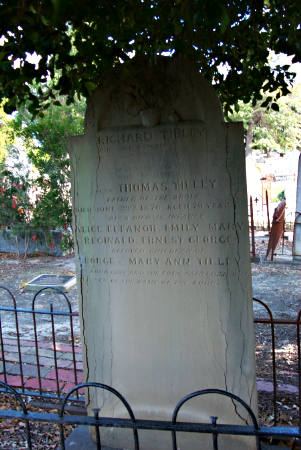
Gravestone of Richard Tilley and other members of the family in the Cheltenham Pioneers’ Cemetery, 2001. Courtesy Graham Whitehead.
After his father’s death George, the youngest son, married Mary Ann Brooks whose family were also market gardeners in the Cheltenham district. The family originally came from Buckinghamshire England. George and Mary had nine children, but four died in infancy. The survivors were Joseph, Henry, Albert, Thomas and Oswald. After inheriting land from his father George acquired two additional portions of land; ten acres on the corner of Farm Road and Warrigal or Moorabbin Road as it was then known, and another thirty acres further down Farm Road. Both of these properties were originally crown allotments. Prior to his death in 1927 George ensured that each of his sons had a holding of land.
Joseph was left the ten acres on Moorabbin Road, Henry had the thirty acre block on Farm Road, while Thomas and Oswald had land in Herald Street. Thomas also had land off Kingston Road. Albert opted not to work the land and instead worked for the Cheltenham Co-operative Society as a storeman and baker, delivering bread by horse and cart.
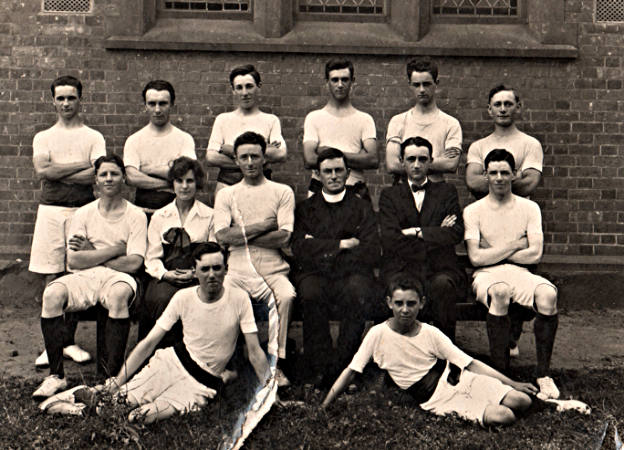
Members of St Matthew’s Gymnastics Club with vicar the Rev Alfred James Thompson. Fourth from the left in the back row is Robert Tilley. Courtesy Barry Tilley.
Joseph and his wife Salina had eight children, Una, Roy, Ivy, Ena, Leo, Amy, Walter who died as an infant and Colin. Both Roy and Colin after leaving Heatherton State School, toiled in the market garden for their entire working lives. Around 1922 Roy was a member of St Matthew’s Boys Gymnastics Club and was a very keen sportsman playing cricket for the Heatherton Club. He served on the committees of both the cricket and football clubs for many years. He also drove the bus on Saturday nights for the dances held in the Heatherton Hall. Roy married Dorothy Ball from another market gardening family on Two Acre Village. Amy, the sixth child of Joseph and Salina, married George O’Dell from a family that also had land in Two Acre Village. The O’Dells are the only branch of the family still involved in market gardening today. Their property is in Pearcedale.
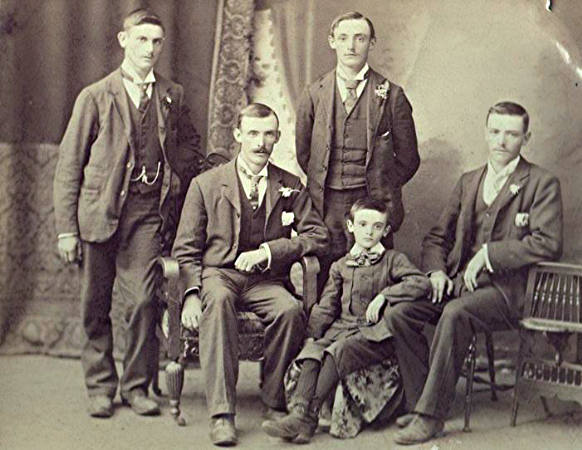
The five sons of George and Mary Ann Tilley. From left Albert, Joseph, Thomas, Oswald and Henry c1920. Courtesy Barry Tilley.
Like all early market gardeners the Tilleys had a pretty tough life by today’s standards, as there weren’t any weed killers, pesticides, prepared fertilisers or means of soil testing. All weeding had to be done by hand or Dutch hoe. Very little could be done to save crops if they were hit by plagues of thrip or other pests. To the best of their ability or judgment crops were sown to suit the seasons as the rain was the only irrigator. There were however two permanent springs in Cheltenham from which gardeners could cart water by horse and dray. One was at the Melbourne Benevolent Asylum on the corner of Warrigal and Kingston roads, and the other was at the end of Glebe Avenue. in the Cheltenham Park. Later, around 1925/26 a stand pipe was installed at the corner of Point Nepean Road and Charman Road which was a great help to the local gardeners.
Joseph and his sons would supply clean bales of straw to racing stables in Mordialloc and would periodically collect the soiled straw from the manure pits. The dray were loaded using pitch forks, then driven back to the garden and forked off into a large pile and left to form compost for a few months before being spread onto the paddocks, again by fork.
All ground preparation and ploughing was done by horse power. A popular breed was the Clydesdale as they generally had a good walking speed. Many gardeners grew a row of flax to supply the strings for tying bunched vegetables and flowers. The flax leaves were thinly stripped to make the tying material. The rows of flax also made an excellent wind breaks.
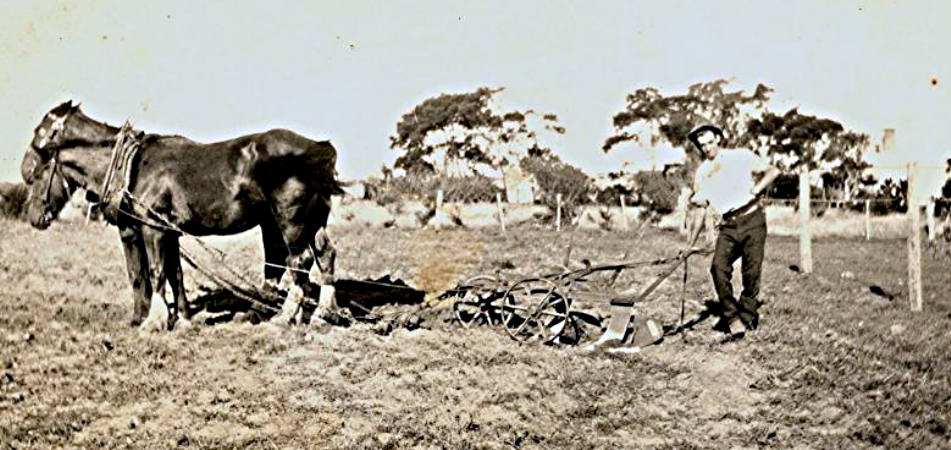
Roy Tilley ploughing his market garden c1920. Courtesy Barry Tilley.
Once, sometimes twice, a week the Tilleys’ produce was taken by horse and dray to the Queen Victoria Market, a trip that would take over three hours, even with a good horse. The return trip was a great chance for a snooze as the horse would find his own way home. Many a time during the great depression, full or near full loads would be brought back and dumped as there was little money around even for food.
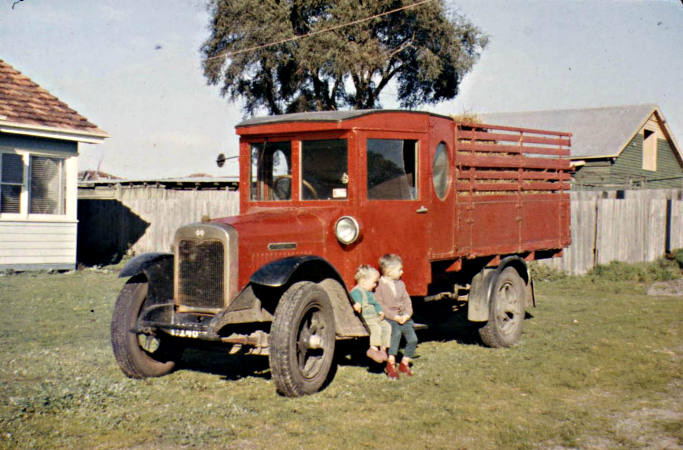
A Tilley Truck, a modern unit that replaced the horse and dray. The two boys, Lance and Paul are the great-great-great grandsons of Thomas Snr. Courtesy Barry Tilley.
Collectively the market gardeners in the Cheltenham area made a valuable contribution to the feeding of our rapidly expanding population.
After five generations in Australia, two of the early pioneer families became united, with the marriage of Roy’s son Barry to Carole Le Page in 1965. Both the Tilley and the Le Page families were early gardeners and residents on Two Acre Village.
